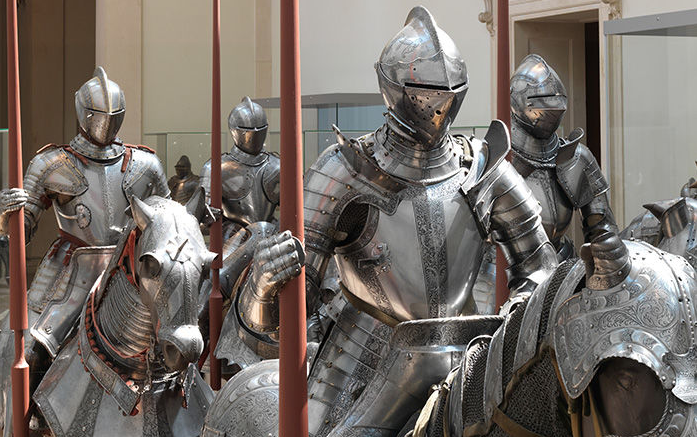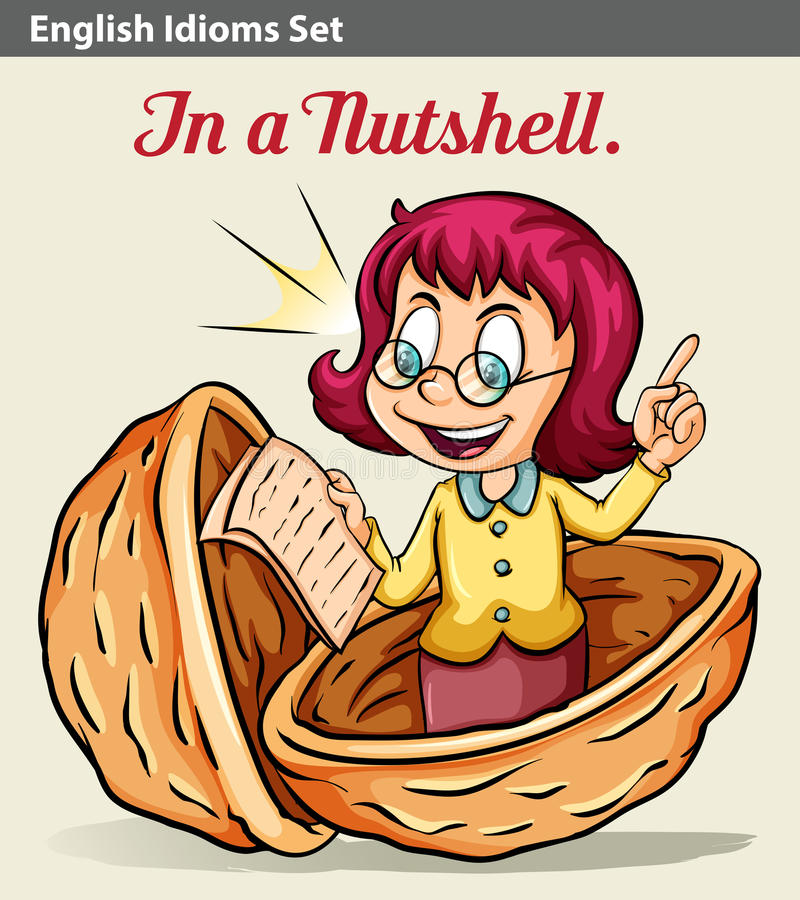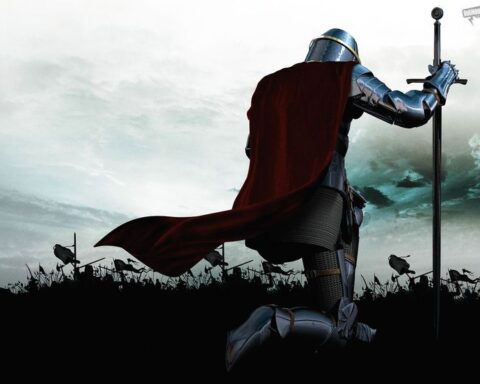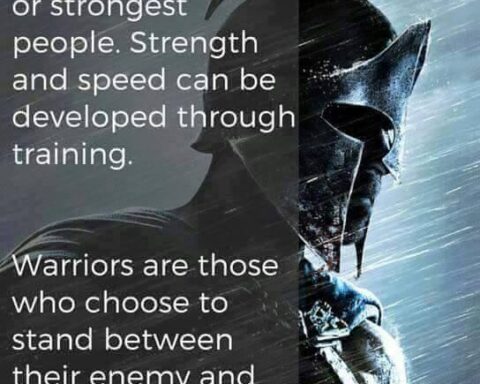Editor’s note: The following comprises Chapter 2 of Chivalry, by F. Warre Cornish (published 1901). Original footnotes are abridged.
The words Chivalry and Knighthood are strictly speaking identical, since Chevalier and Knight[1] are synonyms; but in common usage ‘chivalry’ denotes the whole group of ideas and customs which prevailed among the noble and gentle caste: ‘knighthood’ the estate itself: an estate within which all who were admitted to it were equal, whatever differences of descent or rank might exist among them.
The origin of knighthood is to be sought in the primeval customs of the Gallic and Germanic tribes which overspread the whole of Western Europe, beginning from a period antecedent to all historical records, and only to be traced by archaeological and linguistic evidence.
Although the early institutions of Gaul and Germany closely resembled each other, and Gaulish terms and customs may be observed in French history, the ascendency of the Frankish invaders over the Gauls and the Iberian or Celtiberian population which they had ruled was so complete that the Celtic element in chivalry may be disregarded, until it came in at a late period in a different form and for a different purpose. Historical chivalry is Teutonic, not Celtic. The Frankish horsemen are the precursors of the knights of Christendom, and Baduila the Ostrogoth ‘the first chivalrous figure in modern history.’
Both among the Germans and the Gauls a military democracy, headed by chiefs of divine descent, ruled the subject races and a population of slaves. Among the Germans all free men might attend the meetings of their tribe; they had the right of electing their own chieftains (principes) who, with assessors for the district (pagus), administered justice and interpreted law or custom; they were commanded by generals (duces) or leaders in war; and above these was, in some tribes, a single ruler or king, whom the freemen elected from the members of the royal family, and had the right of deposing in case of unworthiness.
There was thus a double hierarchy; that of the principes, leaders in peace, and the duces, leaders in war and chosen for personal prowess; and above all, and destined to overwhelm the national nobility, the kings.
A similar if not identical constitution existed among the Gauls: and in both races, as they passed from the nomadic to the settled condition, the bond between chief and subjects partook of a double nature, being partly a relation of personal allegiance, (commendatio,) partly a relation connected with the tenure of land and the military obligation, incumbent upon each district, of furnishing a certain number of men to the national levy. The first of these relations is called by Tacitus comitatus: each princeps having attached to him personally a body of freemen who accompanied him in war: the second was developed, as communal property became gradually converted into landed estate, into the military system, whether feudal levy or the militia of districts and counties.
Every youth born of free parents, on attaining military age and having proved his fitness, was admitted into the war-fraternity of the clan and tribe, by the ceremony of investing him with the warrior’s spear and buckler, belt and sword; the spurs, the red robe, the accolade, etc., were added in process of time, but the belt remained as the ‘principal symbol of knighthood, probably (though it had a different origin) coming to be identified with the cingulum of Roman officials.
In all primitive societies the richer class form the cavalry. A knight is a freeman who possesses a horse.[2] The Germans were not a riding people like the Tartars and other steppe-dwelling tribes; but the Goths learnt the use of cavalry in their contest with the Roman empire, and the Gothic cavalier became ‘the arbiter of war, the lineal ancestor of all the knights of the Middle Ages, the inaugurator of that ascendency of the horseman which was to endure for a thousand years.’ The combination of the mailed Gothic or Frankish rider armed with lance and sword and mounted upon the heavy horse, both trained to act in close column, took the place of disciplined infantry; and the history of war till the 14th and 15th centuries is also the history of the predominance of that class which furnished the heavy-armed cavalry man.
Within this class, that of the freemen, all were originally equal: and the equality of knighthood was directly derived from the equality of the freemen. But as the number of ‘knightly’ riders became smaller, owing to the accumulation of land in fewer hands and the substitution of individual for communal property, the government of the tribe tended to become an aristocracy instead of a democracy; and the progress of this change is inextricably mixed up with the development of the feudal system. The idea of equality, however, was never lost sight of; and the equality of all knights in respect of their knighthood was maintained to the last as one of the fundamentals of chivalry. All knights, whatever their degree, were ‘companions’ in chivalry.
Knighthood, when fully developed in the eleventh century a time of action both in inventions and organisation, the period of the Normans and the great popes was looked upon as a reward of valour, a sign of noble birth, a title to land and with it an obligation of reciprocal service and protection, a tie of brotherhood in arms, a religious bond blessed by the Church. All this, as we shall see in a later chapter, was brought into stronger relief by the Crusades, in which knights from every part of Europe met as brothers in arms: and all the incidents of chivalry were heightened by contact with Eastern civilization, and by the national rivalry of princes and noble soldiers. The Church consecrated knighthood by sacramental forms, and almost looked upon it as an eighth sacrament; and about the same time the doctrine of love became an essential part of chivalry, expressed in social life, in war, and in literature. Knighthood, from being a matter of war and feudal dependence, gained dignity by becoming romantic; and whatever unreality may have crept into it in later times, it never lost this character. So great was the dignity of knighthood (a dignity which was only heightened by degrees of rank) that the greatest prince held himself honoured by receiving knighthood at the hands of some famous captain. To wear the Garter or the Golden Fleece was not a mere compliment, but admittance to an inner circle of the brotherhood of knights. We read such titles as ‘Johannes Dux Britanniae, miles‘; as if the knightly appellation enhanced the princely style and to this day the letters K.G. are never omitted after the names of the Queen’s sons.
In our own country, never completely feudal or aristocratic, the development of knighthood was different from that which it received in France and Germany. In the pre-Conquest period, the wars waged in England against invaders and among rival princes were mainly infantry wars, and bore somewhat of a tumultuary character. The relation of land to military service was different from that which prevailed on the Continent, the national force was not so fully organised, and knighthood was less closely connected with rank or feudal dependence. Knighthood, however, both as a token of military honour and as more or less connected with land tenure, existed in England, as in other Teutonic lands, from an early date. Alfred, for instance, knighted his grandson Athelstan, putting on him a red robe and girding him with belt and sword. But knighthood was not universal among the riding classes. It would appear rather to have been re-introduced into England among the Norman customs imported by Edward the Confessor, not having been prominent as an English usage; and it was regarded in England, except in the Edwardian times, rather as a ceremony and an honour than as an estate or a consecration. The English disinclination to take up knighthood as a feudal service appears throughout the Middle Ages, and comes out for the last time in 1630-1640, when the exaction of knighthood fines was objected to Charles I as one of the feudal grievances which led to the Great Rebellion.
The Danish conquest showed the weakness of the English military system. The army of William of Normandy, though not of overwhelming numbers, was superior in almost every respect to that of Harold. He had only to land his forces to ensure the defeat of his enemies.[3] England thus passed under the power of foreign sovereigns whose ideas and whose art of warfare were entirely feudal. Though feudal ideas were favoured at the court of Edward the Confessor, the conversion of the English land tenure into a beneficiary tenure, and the establishment of a class of warrior nobles, clad in armour and forming the heavy cavalry, that is, the main strength of the king’s army, began only at the Conquest. The various circumstances from which it resulted that feudalism never prevailed completely over English customs, and that barons and knights became in process of time not petty sovereigns but wealthy subjects (though this result had an influence on the colour of English chivalry) belong rather to general history than to the study of chivalry.
English chivalry, then, is of later growth than continental chivalry, inasmuch as the conception of chivalry as a part of a system of war, a hierarchy of rank, and a noble training, dates from the Norman Conquest.
The romantic aspect of chivalry, as a brotherhood of noble soldiers, binding all Christian knights into an order, and including in its idea the consecration of the Teutonic military spirit by the Church, and the service of ladies, only attained full development in the course of the crusading period; and it was not till the end of the 12th century that England took a prominent part in the Crusades. The Conquest and the subsequent settlement under Henry I left no leisure for crusading. The second Crusade, that of Conrad of Hohenstaufen and Lewis VII, took place in the crisis of Stephen’s fortunes, and was joined by only a few adventurers from England. Henry II, busy with the affairs of England and half France, looked upon a knight as a tenant who held so many hides of land per servitium militis, and could pay him so much scutage. His marriage with Eleanor of Aquitaine, the queen of troubadours and crusaders, a troubadour and crusader herself, led to a great development of chivalry in the reign of her son. To Richard I, the knight-errant and troubadour, a knight was a man-at- arms for the service of the crusade; a trooper, in fact.
English chivalry, in the romantic sense, dates from Richard’s crusade; and Freeman is so far justified in calling it un-English.
From the time of the third Crusade, England, brought into touch with European romance and enterprise, takes her place as one of the nations of Europe; independent and separate, it is true, but alive to all the movement of the world. The phrases, forms, and sentiments of European chivalry became current in England; and among them may be reckoned the dignity of knighthood, and the poetical aspect of chivalry, heightened as it was by the development of Provençal culture and the exploits of crusaders, which were brought to a focus in the Military Orders. The right of conferring knighthood belonged originally to every knight, since in knighthood all were equal; and this is implied in the romances of chivalry, though the privilege tended to become restricted in practice.[4] In our own country knighthood is now conferred by the sovereign only, or by his deputy, as in Ireland and India. But this is of comparatively recent date. As late as the time of Elizabeth, Leicester and Essex conferred knighthood in the field, and the complaint made against the latter was not that he had usurped the right, but that he had used it too freely. Charles VI and VII made ‘un peuple de chevaliers,’ and the recovery of France from the English was attributed in great part to the valour of the new knights.
It was the custom for the Emperor to make knights at his coronation; and proclamation was always made whether any of the line of Dalberg were present, that he might come to receive the honour first and so at other coronations and royal festivities and ceremonies. Honour is granted by the king; and he does himself honour by surrounding himself with new-made knights. But this right, highly prized when knighthood was a sacrament of military equality, ceased to be valued when it became a bauble of state, and an ornament of nobility.
According to the full conception of chivalry, the estate of knighthood was an honour only to be earned by apprenticeship and trial in arms. And to some extent knighthood was always prized as a reward of valour. But it was also a dignity attached to noble birth without consideration of merit, and one of the incidents of land-tenure. A minor in possession of a ‘hauberk-fief’ or knight’s fee could be compelled by his suzerain to take up knighthood in respect of it, and so do his feudal service, as soon as he reached the age of twenty-one. Knighthood of the ceremonial or complimentary kind was often given at an earlier age. The Children of France were decorated at their birth with the riband of the Saint Esprit, and knighted at the font. Bayard, by request of the Duke of Bourbon, knighted his eldest son, who was ‘still in the hands of nurses and governesses.’ This custom was not confined to royal personages; knighthood was often anticipated in the case of the sons of noblemen. But the strict rule of chivalry was that the novice should pass through the degrees of page and squire, make his proofs of chivalry by practice in the tournament and quest of adventure,[5] and not be admitted to knighthood till the full age of twenty-one, nor until he had proved himself worthy, and until an occasion arrived which made it opportune and dignified. To be knighted on the field was of course the most coveted honour; and we read of squires begging to be knighted before a battle, so as to be able to fight in the front ranks; (‘au premier chef de la bataille’) and of others ‘winning their spurs’ like the Black Prince, in their first battle, and being knighted after it. Thus Lewis IX and Joinville knighted some of their following on landing in Egypt, and batches of knights were made before and after Crécy, Poictiers and Agincourt. In time of peace a squire was thought knightworthy when he had ‘travelled and been in divers feats of arms, and had wherewith to support the estate of chivalry, seeing that it is better to be a good squire than a poor knight… Then shall he take him some lord or gentleman of worth, and beg of him to make him knight in the name of God, Our Lady, and my lord St. George’ (the patron of earthly chivalry, as St. Michael of heavenly) ‘and the good knight shall give him his sword bare, kissing the while the cross of it.’ Some lords, indeed, requited loyal service by refusing knighthood to a good squire for fear of losing a good servant, for a trusty squire, if he could bear the charges of the honour, might demand knighthood at his master’s hands; and on the other hand a squire might have his own reasons for wishing to remain in service beyond the customary seven years:—
Estoit moult de haute gens:
Il n’estoit mie chevaliers:
Vallez[6] estoit: sept ans entiers
Avoit un chastelain servi.
Li vallez n’avoit mil talent[7]
D’avoir armes hastivement.
The age of twenty-one, as being that of full manhood, was fixed at an early period as the date of majority, carrying with it the right of the duel and the conditions of admission to knighthood. The new-made knight was not to repose on his honours, but to prove himself worthy of them by service in the field. To ride about from tournament to tournament, and display horses and suits of armour, as ‘young King Henry,’ the son of Henry II did, was vain glory, not chivalry. Of such a knight Sir Floriant heard a woman cry, ‘He has left chivalry and goes on adventures;’ and Felyce will not have Guy of Warwick till he has ‘won his shoes,’ as well as his spurs.
As long as chivalry maintained its original character, the addition of merit to other claims was never undervalued. A knight was a soldier as well as a gentleman and a land owner, and thought much of the honour of knighthood and the obligation it implied.
In the decline of chivalry, when ceremony had lost much of its meaning, knighthood came to be no more than a title, and was no longer prized as a symbol of personal qualities. But the true spirit of chivalry is expressed in the Romance of Sir Tryamour, where it is said of the novice in chivalry that:—
Eveyr in hys hert he thoght
‘To-day was I y-maked knyght!’
and Sir Perceforest was so joyous in the day of his knighting by King Alexander, that he rode about in the forest alone, ready to tilt at every tree, waving his sword and glorifying in his advancement. ‘Adonc regarde hault et bas, et lui est advis que c’estoit belle chose d’ung homme quant il est armé. Lors se pensa qu’il s’anneroit du tout… lors va saisir à pannoyer et à escremer et à tournoyer entour son chef, et dist à soi-mesmes: “Or ne me fault riens de toute ma joye, fors que je trouvasse à qui jouster pour scavoir si je pourray aulcune chose valoir.”‘
Among the gentler features of chivalry may be reckoned the beautiful institution of brotherhood in arms, by which two knights vowed faith and love to each other.[8] The brothers in arms wore the same arms and clothes, mingled their blood in one vessel, received the Sacrament, and kissed the pax together.[9] They engaged to support each other in battle and in all quarrels, and to have the same friends and enemies. Brotherhood in arms over-rode all duties, even to ladies, except those which were owed to the Sovereign. Hence when Henry Bolingbroke Duke of Hereford deposed Richard II, Lewis Duke of Orleans annulled the treaty of brotherhood which he had made with Bolingbroke some years before, and challenged him to combat at any place in France with 100 knights and squires on either side.
Du Guesclin was brother in arms of Olivier de Clisson, and the Act of their brotherhood, like that of Bolingbroke and Orleans, has been preserved. They agree to support each other against all the world except the King of Rome and his brothers, the Viscomte de Rohan and their several liege lords, they will share all ransoms of prisoners and lands, will acquaint each other of any mischief intended, and will guard each other as brothers. The Seigneur de Coucy was also a brother in arms of Clisson[10] and ‘moult s’ entray moient et s’appelloient frères et compagnons d’armes.’ Gilles de Brun, Constable of France, was brother in arms to Joinville. So too Lewis XI and Charles of Burgundy; ‘prenons et acceptons en nostre seul frère d’armes’ is the phrase of their contract.
In the romance of Guy of Warwick, Sir Guy and Sir Tyrry say:—
Wyll we now trowthe plyght,
And be felows day and night;
And whyll we be levande[11]
Nodur fayle odur in no lande?
Though knighthood fell as far short of the chivalric ideal as Christian life of the Gospel rule, the ideal was kept in view;—
L’ordre demande nette vie,
Chastete et curtesye
and
Vous qui voulez l’ordre de chevalier,
Il vous convient mener nouvelle vie.
It was a limited and imperfect ideal; but readers of Froissart and Sir Thomas Mallory cannot doubt that with all its faults it raised the life of those who aspired after it.
The spirit of chivalry can exist without its forms. Perhaps no more perfect example of a chivalrous nature can be found than that of Nelson. He was proud, resentful, harsh in his judgements, and unscrupulous in his actions. But in daring courage, generosity, good faith, and noble desire of glory, he was the very type of a knight; and his greatness kindled all with whom he came in contact. The ‘Nelson touch,’ as he proudly called it, was felt in all the fleet and through the country, in the same way as the character of the Black Prince was felt. Nelson’s passion for Lady Hamilton completes the picture. In the middle ages this would have counted among his virtues. The estimate of his own times and of the succeeding generations makes allowances for it, and forgives the hero his madness. ‘If there were more Emmas, there would be more Nelsons’ is the finest possible expression of the chivalrous virtue ‘donnoy,’ the subjection of the man-at-arms to his lady. It is unchristian and fantastic — un-English if you will. It may and must be blamed, but it cannot be despised; and there is an element of beauty and nobility in it.
Cervantes is credited with the design of satirising chivalry. But under all the mean incidents and meaner characters of the novel, we feel that Don Quixote is, and is accounted to be, a hero, putting to shame the silliness of the sane, and the good sense of his matter-of-fact squire. His character outshines its fantastic ornaments. And Sancho Panza’s faithfulness is not merely that of a dog or a slave. He has sense enough to know that his master is in the right; and the moral of the book is that the foolishness of an ideal is wiser than the wisdom of the world.
Chivalry receives an illustration also in the life of St. Francis, the knight of holiness. His life is the chivalrous life translated into a higher sphere. Christ is his Amadis or Lancelot, the ‘Master’ whom he served as squire. Poverty is his lady: and his devotion to both is without limit or reserve.
Non era ancor molto lontan dall’ orto,
Ch’ei cominciò a far sentir la terra
Delia sua gran virtute alcun conforto;
Chè per tal donna giovinetto in guerra
Del padre corse, a cui, com’ alla morte,
La porta del piacer nessun disserra;
Ed innanzi alla sua spirital corte
Et coram patre le si fece unito;
Poscia di dì in dì l’amò più forte.
Ma perch’ io non proceda troppo chiuso,
Francesco e Povertà per questi amanti
Prendi oramai nel mio parlar diffuso.[12]
St. Francis would be as impossible as Sir Galahad without the ideal of knighthood, which is, in one word, service.
It is easy to say that knighthood was an ignis fatuus, leading the visionary to a land of chimeras; that it had no relation to the love of God and man, to the misery of the world and to humble Christian goodness; that it was founded on pride, and at best was but a soldier’s virtue, a virtue of paradox. At any rate, it aimed higher than the common scope of the world. The pride of the true knight was pride in his order, not in his own deeds: he did not worship himself or his theories, but was a humble son of the Church: if his obligation of courtesy was too much confined to his own order, it taught him self-control, self-respect, and consideration for the weak; if it did not make his life as pure as the sentiment which he acknowledged, it was better than the gross licence out of which it sprang and against which it protested. The brotherhood of chivalry, contradicted every day by arrogance, self-will, and jealousy, was yet a reality, and bound individuals and nations together: the point of honour, foolishly distorted by sensitiveness of self-assertion, preserved the sanctity of truth, and made meanness infamous; the obligation of courage, whilst it made men quarrelsome, ennobled resistance; pride itself, parage not orgueil, was a check upon the servility of a society which did not know the meaning of liberty, and in which slavish obedience was the common rule, enforced by all who had power in their hands; liberality, fantastic and extravagant, was more noble than money-getting; the love of ladies, destructive of domestic life and full of false sentiment, was better than the mere animal passion of barbarous Huns, Goths, and Northmen. In a word, the consecration of the Teutonic soldier to a rule of life, a brotherhood and equality of noble service, a discipline of life-long obedience, a sense of personal honour and rectitude, though inferior to the Roman conception of civic virtue, was an education of those who bore rule in the world, and made them more worthy of the position which they had won and maintained by force, than if they had never bowed to the yoke of the Church and learnt from her teaching the lesson of noblesse oblige.
It is not easy to conceive of knighthood, apart from its garnishing, as a reality: but so long as it flourished it was in fact among the most real of institutions. The knightly brotherhood and the Catholic Church were the two principal institutions of the Middle Ages, the embodiment of the love of war, the love of ladies, and the love of God. Desire of political power, personal ambition, greed of money, the development of political and social institutions, the rivalry of classes and races, the growth of a commercial and civic interest, the aims of international trade, were then as always factors in the sum of human motives. But the ruling motives among the dominant class were those connected with chivalry and religion; their dictates were implicitly obeyed, and their rewards and censures regarded above all others.
The passionate devotion to chivalry which belongs to its best age may be seen indicated in the romance of Tristan, where the dying knight says: ‘I take leave of chivalry, which I have much loved and honoured. Alas, my sword! what wilt thou do now? Thou wilt leave thy master, never wilt thou have another so good. Wilt thou hear, Sagremor the most shameful word that ever passed the lips of Tristan?… I am conquered. I give thee my arms, I give thee my chivalry.’ He kisses the pommel and the blade of his sword, and his shield. ‘Ah! why should I die so soon? Adieu, my good sword!… grief makes my heart burst. Sagremor, I deliver to you my heart and my sword: honour them as myself, if you ever loved Tristan.’ When Lancelot disguised as the Black Knight discomfits all Arthur’s knights, Gawain faints for sorrow. ‘Il aymeroit mieulx mourir en ce poinct que veoir toute chevalerie morte et honnye.’
If this is extravagant, it is also genuine, and pitched in a high vein of sentiment. Knighthood thus conceived is something higher than the self-assertion of a dominant aristocracy. Pride is tempered with humility; courage and honour are the accompaniments of loyal service; the knightly devoir is free from personal self-exaltation; Galahad and Lancelot become not mere shadows, but types of soldierly excellence and courtesy, exhibited on battlefields and in the bowers of ladies.
If such was the glory of knighthood, its laws and observances, not only ‘achievement high’ but ‘circumstance of chivalry,’ the ceremonies which accompanied it had a like dignity and authority. The men who revered them were neither barbarians nor children, nor even ‘noble boys at play.’ Their lives were serious, manly, and eventful; their virtues and vice alike pitched in a higher key than our own.
__________________________________________
[1] The A.S. word cniht (boy, youth) was used before the Conquest to mean a dependant holding land from one of the great vassals by knight service (militia), whether dubbed kniyht or not. Similarly serviens (serjeant or esquire) is a military dependant not of knightly estate.
Oman, Hist: of the Art of War, p. 369.
[2] Omnes pagenses, Franci qui caballum habent vel habere possunt were commanded by Charles the Bald to bear arms (militare).
[3] Strictly speaking, the defeat at Hastings was brought about by the English leaving their shield-wall formation; but the want of a standing army at the King’s disposal, and of a proper force of cavalry put the English at a disadvantage. The time spent in marching south from Stamford Bridge might have been made up, if any effective organisation had existed.
[4] Joinville, just before landing in Egypt (as if it were before a battle), knighted a young squire of noble birth, Monseigneur Hugh de Vaucouleurs, as well as two squires who had quarrelled on the way out, and whom perhaps he wished to unite in a chivalrous friendship.
[5] Chaucer’s knight had travelled all over the world; and his son the squire had presumably been his companion in some of his adventures.
[6] squire.
[7] desire.
[8] This custom is of ancient origin. The Scandinavian warriors mixed their blood and drank it; a like ceremony is mentioned by Xenophon in the Anabasis.
[9] The Greek Prince of Edessa adopted Godfrey of Bouillon as his son by taking him ‘between his shirt and his skin.’ – Gibbon. Chap. lviii, Ducange, sur Joinville. Dissert, xxii.
[10] and also of Louis de Sancère.
[11] living.
[12] Dante, Paradiso, xi. 55-75.









